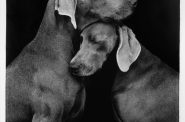Rodchenko’s “Composition”

Alexander Rodchenko (Russian, 1891-1956) Composition, ca. 1917 Oil on panel 22 7/8 x 10 in. Purchase with funds from the Walter Family in memory of Nadine Walter M1992.120
The blunt, rough abstraction of Alexander Rodchenko’s Composition (circa 1917) hits hard. The overlapping red/orange and old gold triangles have none of the mystic aura of, say, Mark Rothko’s work. Composition is too sharp for that, too hard-edged. The wedges stab into the frame. (You could read the gold triangle as cutting into the orange one.) Vigorous brushwork at the white fields around the sharp points of the triangles suggest water split by the advancing prows of ships.
The rough material matters. Rodchenko painted on an old wood panel, perhaps a piece of siding yanked off a building. It’s warped up and down, concave in the center and convex on the right. It is only more or less rectangular. Around part of the edge, some white paint has chipped away and raw wood shows. Rodchenko didn’t bother to fill in a knothole near the center of the panel.
The museum displays it glassed within a neat white box on the wall. It might be better nailed to the wall or even leaned casually in a corner. The piece is just under two feet by 10 inches. You could whack someone with it, and the initial effect is something like a two-by-four to the forehead.
Upon closer inspection, the initial crudeness of Composition yields to unexpected subtlety and rigor. The orange triangle is graded from dark at the top to brighter and lighter toward the bottom. The gold is the inverse, rising from brown/black at the bottom to a nearly iconic sheen at the top. The inversion of hue echos the inversion of shape; smart. The gold triangle exits the frame at the upper left, the orange one at the lower right. The shapes and relations are off just enough to reveal the artist’s willful hand.
Once the relationships of the triangles become clear, the more complex relations of the six white fields around the triangles present themselves. The triangles split the white field into another series of inversions and related shapes. Composition has a bold visceral side, but it is also an engaging geometry puzzle.
Whatever his later sins, Alexander Rodchenko was an artist of great brilliance and originality. Composition shows what might have been.
Print out this story and present it at the Milwaukee Art Museum admissions desk for a $2 discount. Offer good through Sept. 12.
Art
-
Exhibit Tells Story of Vietnam War Resistors in the Military
 Mar 29th, 2024 by Bill Christofferson
Mar 29th, 2024 by Bill Christofferson
-
See Art Museum’s New Exhibit, ‘Portrait of the Collector’
 Sep 28th, 2023 by Sophie Bolich
Sep 28th, 2023 by Sophie Bolich
-
100 Years Of Memorable Photography
 Sep 18th, 2023 by Rose Balistreri
Sep 18th, 2023 by Rose Balistreri

















Nice painting!